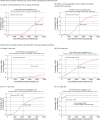Opportunities for improving the efficiency of paediatric HIV treatment programmes
- PMID: 25396263
- PMCID: PMC4318642
- DOI: 10.1097/QAD.0000000000000518
Opportunities for improving the efficiency of paediatric HIV treatment programmes
Abstract
Objectives: To conduct two economic analyses addressing whether to: routinely monitor HIV-infected children on antiretroviral therapy (ART) clinically or with laboratory tests; continue or stop cotrimoxazole prophylaxis when children become stabilized on ART.
Design and methods: The ARROW randomized trial investigated alternative strategies to deliver paediatric ART and cotrimoxazole prophylaxis in 1206 Ugandan/Zimbabwean children. Incremental cost-effectiveness and value of implementation analyses were undertaken. Scenario analyses investigated whether laboratory monitoring (CD4 tests for efficacy monitoring; haematology/biochemistry for toxicity) could be tailored and targeted to be delivered cost-effectively. Cotrimoxazole use was examined in malaria-endemic and non-endemic settings.
Results: Using all trial data, clinical monitoring delivered similar health outcomes to routine laboratory monitoring, but at a reduced cost, so was cost-effective. Continuing cotrimoxazole improved health outcomes at reduced costs. Restricting routine CD4 monitoring to after 52 weeks following ART initiation and removing toxicity testing was associated with an incremental cost-effectiveness ratio of $6084 per quality-adjusted life-year (QALY) across all age groups, but was much lower for older children (12+ years at initiation; incremental cost-effectiveness ratio = $769/QALY). Committing resources to improve cotrimoxazole implementation appears cost-effective. A healthcare system that could pay $600/QALY should be willing to spend up to $12.0 per patient-year to ensure continued provision of cotrimoxazole.
Conclusion: Clinically driven monitoring of ART is cost-effective in most circumstances. Routine laboratory monitoring is generally not cost-effective at current prices, except possibly CD4 testing amongst adolescents initiating ART. Committing resources to ensure continued provision of cotrimoxazole in health facilities is more likely to represent an efficient use of resources.
Figures
References
-
- UNAIDS Global Report. UNAIDS report on the global AIDS epidemic 2013. Geneva, Switzerland: UNAIDS, 2013, p. A91.
-
- World Health Organization. Antiretroviral therapy of HIV infection in infants and children: towards universal access. Recommendations for a Public Health Approach; 2006. Geneva, Switzerland: World Health Organization; 2006, pp. 13–16. - PubMed
-
- Drummond M, Sculpher MJ, Torrance GW, o’Brien BJ, Stoddart GW. Methods for the economic evaluation of healthcare programmes. 3rd ed Oxford, UK: Oxford Medical Publications; 2005.
Publication types
MeSH terms
Substances
Grants and funding
LinkOut - more resources
Full Text Sources
Medical
Research Materials


